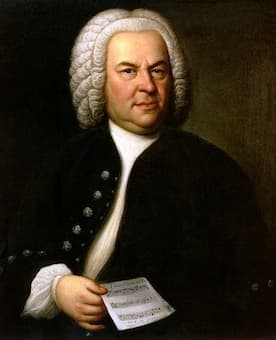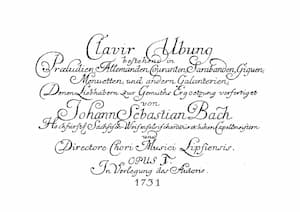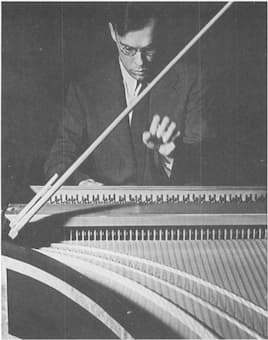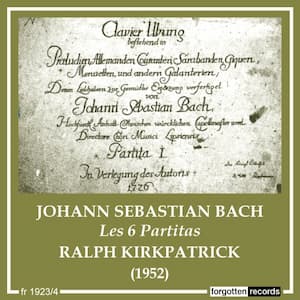
Elias Gottlob Haussmann: Johann Sebastian Bach
in 1746 (2nd version)
Between 1725 and 1731, Johann Sebastian Bach (1685-1750) wrote the last of his keyboard suites. His earlier suites, the six English Suites, BWV 806-811, the six French Suites, BWV 812-817, and the Overture in the French style, BWV 831, culminated in the Partitas, BWV 825-830. They were published individually starting in 1726 and then gathered as the Clavier-Übung I in 1731.
On the title page, Bach lists all the kinds of movements that are in the collection: Preludes, Allemands, Courants, Sarabands, Gigues, Minuets and other ‘Galanterien…’, meaning ‘other dances in the Galant style.’
In keeping with the naming of the earlier suites as English and French, the six Partitas are sometimes called the German Suites. However, this is just following a model for no reason. The name labels come from the 19th century, not the 18th and there’s nothing intrinsically German about the Partitas.

Title page of the Clavier-Übung (1731)
The period in which Bach was writing these works occurred when he became cantor of the Leipzig St. Thomas Church. In this same time period, he wrote three complete cantata cycles, an expanded Christmas arrangement of the Magnificat, two versions of the St. John Passion and the St. Matthew Passion. In 1729, Bach also took over direction of the Collegium Musicum for students, which had been founded by Telemann. In addition, he had to deal with the petty annoyances of his bosses, who had other priorities than music. Bach wrote one Partita set a year and had them printed at his own expense. The work in its six parts is considered a ‘brilliant finale for the genre of the keyboard suite.’ When they were published, they ‘caused a great stir in the musical world,’ according to the contemporary music theorist Johann Nikolaus Forkel.
Each of the Partitas begins with a different opening movement. Partita No. 1 has a ‘pianistic Prelude,’ No. 2 begins with a three-part Sinfonia, No. 3 with a Fantasia in the style of a 2-part Invention, No. 4 with a French-style Overture, No. 5 with a Preamble in the style of Scarlatti, and the last with a Toccata like an old North German organ Fantasia.
J.S. Bach: Partita No. 1 (Ralph Kirkpatrick, harpsichord)

Ralph Kirkpatrick playing his
Dolmetsch-Chickering harpsichord, 1939
The performer, American keyboardist and musicologist Ralph Kirkpatrick (1911-1984) did much to bring Domenico Scarlatti’s keyboard music up-to-date, starting with a catalogue and then performances of the works. He made his European debut with Bach’s Goldberg Variations in 1933 and performed widely through the US and Europe from the 1930s to the 1980s. He was on the faculty of Yale University for 36 years, retiring in 1976 when he became blind. On this recording, made in 1952, he plays a harpsichord made in Boston by Chickering and Sons, dated 1908. Chickering & Sons were advised in the making of their harpsichords by Arnold Dolmetsch (1858-1940), a French-English musician and musical instrument maker who was instrumental in the 20th-century early music revival starting at the turn of the century. He worked with Chickering and was resident in Boston from 1905 to 1911.

Performed by
Ralph Kirkpatrick
Recorded in 1952
Official Website
For more of the best in classical music, sign up to our E-Newsletter
